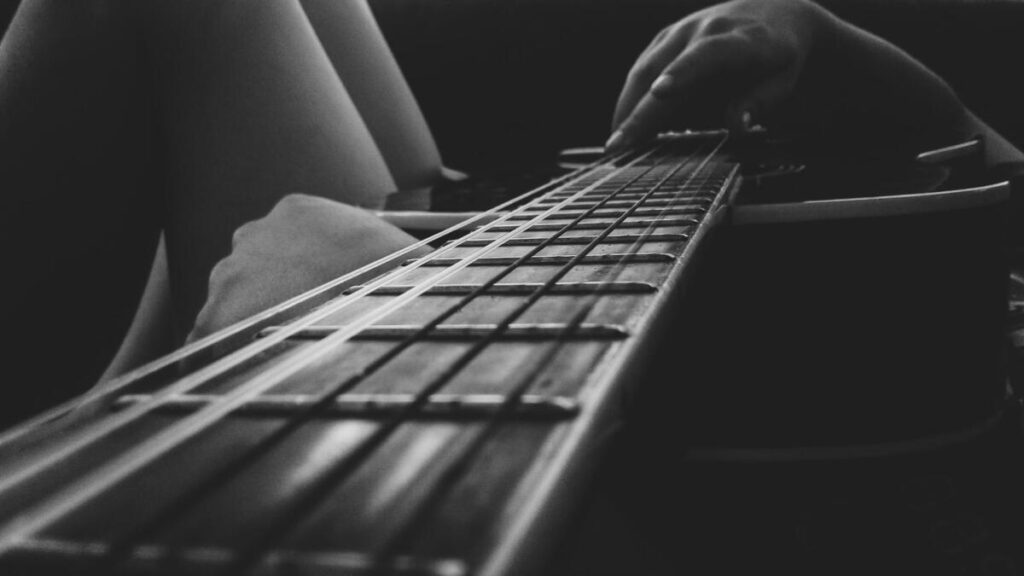If you are just starting on the guitar with some beginner guitar lessons, the strumming process can seem like a daunting hill to overcome. Besides learning how to move your wrist in a particular up-and-down movement, you will also have to study modern rhythms. These basic syncopated patterns and techniques will be the key to playing and strumming the guitar like a pro.
First Learn a Chord Progression
Before you start playing your first strums, make sure you know at least one chord progression. Many songs use chord progressions as their structure, so it helps to start learning them as soon as possible. The most common progression is the 1-4-5 or notated as I-IV-V. In the key of C, the chords are C-F-G, if you want to play a 1-4-5 in the key of G the chords are G-C-D. Use a guitar chord chart to help you find these chord fingerings.
It is important to know at least three chords that fit together when strumming. Your picking or strumming hand will not be the only one moving. It is important to be able to move chord shapes while strumming at the same time. An easy way to approach this is by using barre chords. By sticking to a chord progression you can repeat G-C-D over and over while you work out the strum.
Study Rhythm Basics
Besides the chords, each genre of music has specific rhythms. Most popular music is in 4/4 time which is counted in quarter notes of 1 2 3 4 and has an accented backbeat on the 2 and 4. Syncopation is essential and all about the movement of the rhythm, creating space and accenting notes helps “swing” the groove.
The bass drum often hits on the 1 and 3, while the louder snares play on the 2 and 4 backbeats. The hi-hat keeps a steady stream of 1/8 notes playing the entire time.
1 and 2 and 3 and 4 and
When you are playing rock and pop, eighth notes will be common in your strums. If you want to get a funkier vibe going, add in sixteenth notes. Any added notes will help with the syncopation. EDM uses a bass drum on every note to create a dancing drive and Reggae is known for the staccato playing and accent on the 3rd beat. Each genre of music has these distinct rhythm markers, and they should be found out before playing. Listen to the exact songs that you want to strum before jumping in.
Common Beginner Guitar Strum Patterns
Before you start strumming be sure to
- Maintain proper posture
- Loosen up and do not keep the elbow rigid
- Most strums are in the wrist, keep it flexible but in control
- A metronome, drum app, or backing track is essential to practice to
- Start slow and play correctly before increasing your speed
All Downstrokes
The most basic strum for beginner guitar players is simply all downstrokes, many genres like heavy metal rely on this simple but powerful strumming. Turn the metronome or drum app on and keep the down strum as simple as you need it, start with quarter notes, and then add in the “and” as we move into eighth notes.
It will sound monotone until you start changing the chords and the dynamics. Experiment with how hard you hit the strum by accenting certain beats, namely the 2 and the 4. Or strum harder on the beat and lighter on the “and” or offbeat, and play around with different accents on different downstrokes.
Pay close attention to the movement and direction of the pick, we want a clean sweep down all the strings we need to hit. As we add in upstrokes our pick will change direction (or our fingers if we are using fingerstyle).
Adding in Upstrokes
While playing your eighth note downstrokes start adding an upstroke on each offbeat. This will give you a back-and-forth down-and-up pick movement.
1 + 2 + 3 + 4 +
DU DU DU DU
Some styles will play all the eighth notes, while others mix in quarter and eighth together, like these mixed strums.
1 + 2 + 3 + 4 +
D DU
This strum will sound nicely against the backbeat of the snare.
1 + 2 + 3 + 4 +
D DU DU
This is often a strum used in a laid-back and groovy pop genre. If you can play the strum faster and add sixteenth notes in, it will be even funkier.
1 e + a 2 e + a 3 e + a 4 e + a
DUDU DUDU
Playing that pattern in a strong but muted way will give you the sound of funk guitar. Experiment with your own down and up patterns using a mix of note values and be sure to add in rests to help with the syncopated groove.
Before moving to the next strum try playing the G-C-D progression with two different strums. Try a verse with just a DUDU and then play a little harder on the chorus with just downstrokes DDDD. Many songs you play will incorporate multiple strumming patterns so practice changing.
Clawhammer or Bass Note Picking
Clawhammer started on the banjo with the basic concept of plucking a bass string and then strumming the treble strings. It has many different names and variations like Travis picking and is often heard in folk and country.
Start by plucking the lowest bass note of the G chord and then two lighter upstrokes on the treble strings right after.
1 + 2 + 3 + 4 +
D UU D UU
This gives us the class bum ditty sound that is central to many popular songs. As you switch chords with each measure make sure to strike the lowest bass string before the quick upstrokes.
You may not always hit all the treble strings on your upstroke, the key is all about getting the rhythm right. And often this bass-centric strum will be mixed with the other regular strums above.
Muting String Strums
Keeping our neck strings muted will often help to achieve staccato and quick rhythms, but we can also add a mute in with the palm of the strumming hand. As you strike or pluck the strings, immediately mute them with your palm, this will cut the note off giving it a unique sound. If you strum and mute at almost the same time, it will give a very tight vibe.
This quick muting is often done on the 2 and 4 backbeats to add more syncopation.
1 + 2 + 3 + 4 +
D DU D DU
When you do the quick mute it makes the song have less of a folk-type of vibe and moves into more rhythmic rocking and funky territory. Or you can start on an upstroke and use muted strings for a more island vibe. These same patterns can create new genres and different styles with such simple changes.
1 + 2 + 3 + 4 +
U DU U DU
As you get a feel for the most basic strums, start adding in more eighth notes and try different patterns. And of course, try different strums with time signatures like 3/4.
1 2 3
DUU
1 2 3
DDU
After you are comfortable with one chord progression practice over another with these same patterns. At the beginning of guitar playing, strumming can seem monotonous and robotic, the key is to keep practicing. And the best practice is to listen to the song you want to play over and over while you flesh out the strumming pattern. Just keep that wrist loose and relax, let your hand flow with the rhythm!
By Shawn Leonhardt for Guitar Tricks and 30 Day Singer



